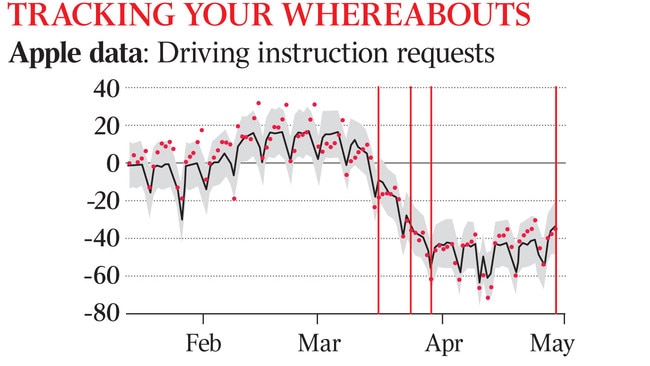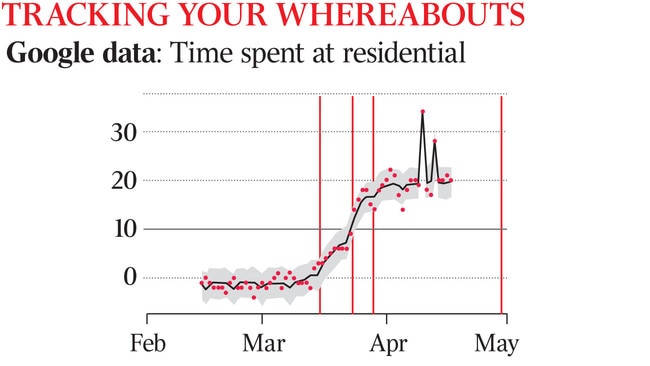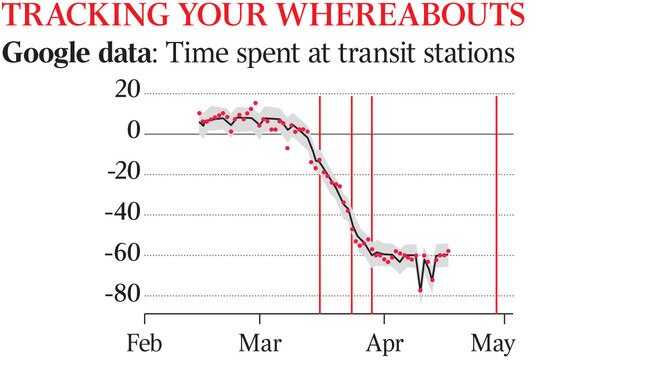Coronavirus: tech data shows how we curbed travel to flatten curve
Data harvested by tech giants Google and Apple has illustrated the sharp impact of coronavirus containment measures.

Data harvested by tech giants Google and Apple has illustrated in stark detail the sharp impact of coronavirus containment measures across the country, with the information showing just how effective measures to limit movement have been.
Australia’s Chief Medical Officer Brendan Murphy released new information on Friday showing the dramatic changes in the way people across the nation had changed their behaviour during the outbreak.
The data shows a 60 per cent-plus fall in searches for driving directions through Apple technology in NSW, reflecting what Professor Murphy said was the success of the restrictions introduced in the state.
“This is showing how well people have adhered to our measures that we’ve put in place,” he said. “You can see some little spikes around Easter time but, generally, people are doing the right thing.”

Data from Google shows similar trends. Google information shows that time spent by people in transit stations fell as much as 80 per cent in the wake of various measures aimed at limiting gatherings and restricting movement, with the data also pointing to an inverse rise in the amount of time spent at home.
While the uptake of the government’s COVIDSafe app has been slowed by concerns about privacy and the safety of data, the data highlighted by the professor shows that Australians have few concerns about giving away that same data to tech giants.
It was a point not lost on Professor Murphy, who again called for more Australians to sign up to COVIDSafe.
“Google does track people, the COVIDSafe app doesn’t,” he said.
The data has been compiled by the Peter Doherty Institute for Infection and Immunity, which will release a report on Monday detailing similar measures for other states. The latest update came as Australia continued to make progress in tackling the virus.
Just 16 new cases were confirmed nationwide in the 24 hours before Friday’s update, continuing the flattening of the curve.
Australia’s success means bureaucrats have the very welcome problem of not having sufficient data to run their modelling.

Professor Murphy said NSW and Tasmania were now the only two states that had a statistically significant volume of cases to warrant modelling of the virus’s effective reproduction rate number — a figure that illustrates the pace at which the virus spreads to other people.
Figures out of the ACT and the Northern Territory fell below the required threshold last week, and almost every other state has now dropped below that level.
“The case numbers in every other jurisdiction are so small that the modellers feel that they can’t usefully use the effective reproduction number,’’ he said.
“Those error margins are so broad in the other jurisdictions that the modellers aren’t comfortable with producing it,
“Only in NSW and Tasmania are there enough numbers to show an effective reproduction number. And even then, they’re pretty much at the lower limit of what you would expect.”
The reproduction number in Tasmania has now fallen below the benchmark of one, at which the virus diminishes.




To join the conversation, please log in. Don't have an account? Register
Join the conversation, you are commenting as Logout